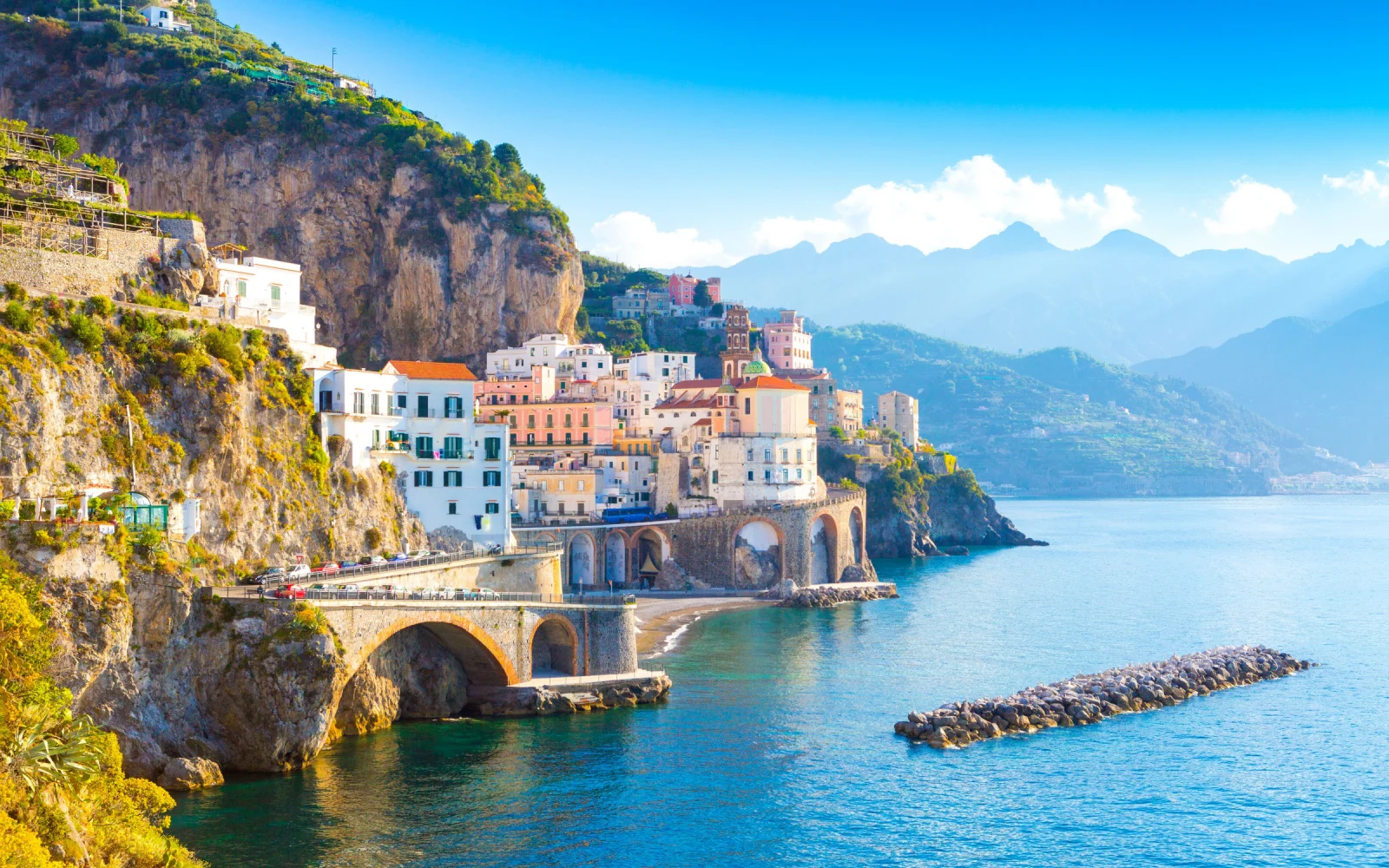Italy is one of the countries with the most tourist arrivals in the world. According to some statistics, it is the fifth most-visited country in the world, with about 64 million annual visitors who come to check out its beautiful nature, historic sights, and amazing culture.
No visit to Italy is complete without a trip to the capital Rome, with its iconic ancient Roman sites, the center of Catholicism at the Vatican City, and world-famous gastronomy.
Art lovers flock to Venice, while fashion lovers visit Milan. Italy has thousands of miles of coastline, from the beaches of Sicily to the craggy hills of Cinque Terre, and plenty of hiking and cycling trails.
Of course, the food is fabulous as well, from the street food of Naples to the delicious food of Tuscan small towns.
The hardest part about planning a trip to Italy is narrowing down where you want to go, not picking out what to see. However, sometimes people get so distracted by the fun parts of trip planning that they forget to research practical concerns such as safety.
This travel guide will help you ensure that you visit Italy safely, no matter what happens. A little research ahead of time can help you have peace of mind during your trip!
Is Italy Safe to Visit in 2025?
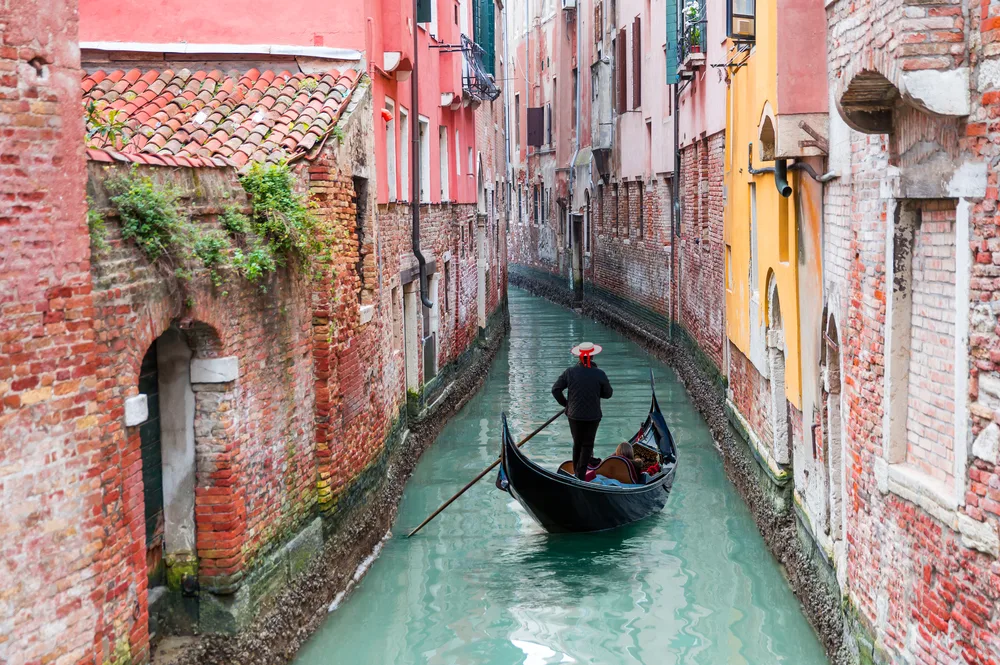
muratart/Shutterstock
Yes. Italy is safe to visit, although you may need to use some common-sense precautions while you are on vacation.
Tourists are sometimes affected by crime in Italy, but they are usually petty incidents such as pickpocketing. Italy also experiences other problems ranging from natural disasters to terrorism, but travelers tend to be protected from the consequences of those issues.
A good place to start researching any new destination is travel advisories. Most countries agree that Italy is a safe place to visit.
Countries such as Canada give their citizens the green light to visit Italy, just telling them to “exercise normal precautions” (the lowest possible advisory level). Other countries are a bit more cautious about their travel advice for Italy.
The United States puts Italy under a level two travel advisory. This doesn’t mean that Italy is necessarily dangerous to visit, just that the government recommends using some additional precautions when out and about.
Common problems that travel advisories mention for Italy include:
- Petty crime
- Break-ins
- Drink spiking
- Verbal harassment
- Organized crime
- Natural disasters
- Terrorism
Many countries, especially the United States and New Zealand, mention the risk of terrorism in their travel advisories for Italy. It is true that there is a risk of terrorist attacks in European countries, including Italy.
Although the Italian government has foiled plans by attacks by individual terrorists in recent years, there have been no recent mass terrorist attacks. The risk of experiencing one while in Italy is actually very low.
Most people associate Italy with the mafia and organized crime.
Although the country has come a long way since the days when mafia shootouts were regular occurrences, the mafia still has an uncomfortably strong presence, especially in the south, and is closely involved in many businesses.
However, the mafia has no interest in dealing with tourists as its main focus is large-scale crime and corruption. You don’t have to worry about running into the mafia, as long as you aren’t planning to make shady business deals while you are in Italy.
Italy experiences some natural disasters, and these extreme weather events have been getting worse as the climate intensifies.
In July 2023, parts of Italy, including Sicily, suffered from large wildfires caused by extreme heat. In May of the same year, they displaced tens of thousands of people in the north of Italy.
Although these disasters are not common, they can happen during your trip. Make sure that you are following the news and obey any evacuation orders that the government may issue. Keep seasonal threats in mind, such as the threat of wildfires in the summer.
Crime in Italy
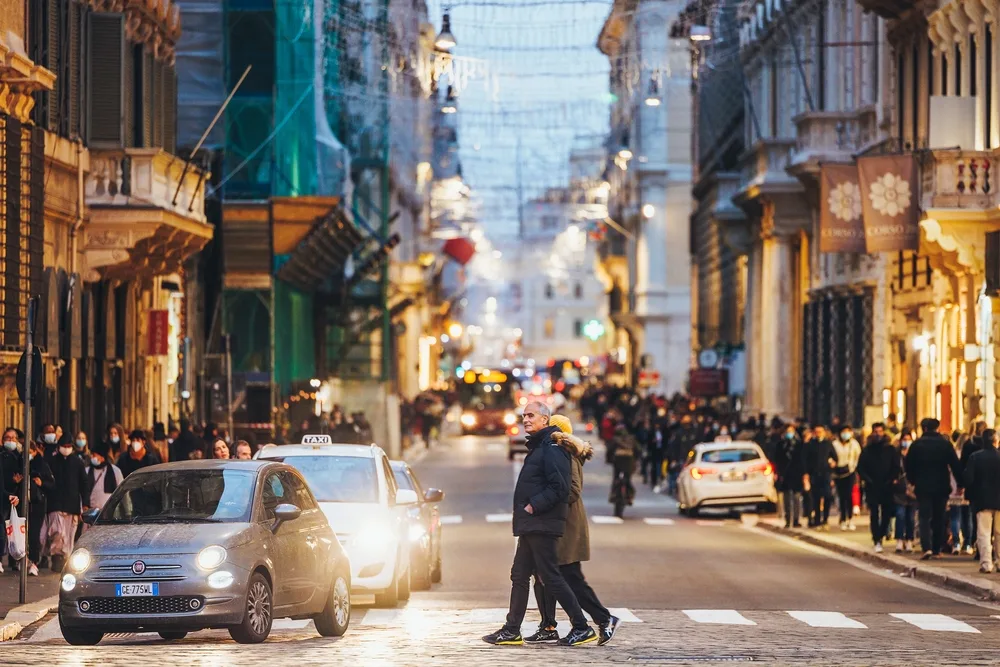
Rome, Italy – December 2021: People crossing the street in the evening, with a view of crowded sidewalks during the holiday season/Salvador Maniquiz/Shutterstock
Crime is a common concern for people going abroad. Italy’s reputation is unfortunately closely tied to crime, so you may be wondering how much of what you heard is based in stereotypes, and how much on the truth?
It is true that crimes are committed in Italy, just like they happen anywhere else. In 2019, there were 2,301,912 total crimes committed in Italy.
Over the past decade, the crime levels in Italy have been steadily decreasing, despite a slight bump after the end of COVID-19 lockdowns. The violent crime rate in Italy is very low.
The homicide rate is just 0.51 incidents per 100,000 people, which is a very low number and one of the lowest homicide rates in the world. Since homicide rates are usually similar to the rates of other violent crimes, it’s safe to assume that the rates of other violent crimes are also low.
Most crimes committed in Italy are non-violent property crimes, just like in most other places. In 2019, theft made up 46% of total crimes reported.
Common forms of theft include street crimes such as pickpocketing, tourist scams, fraud, and bag snatching. While embarrassing and inconvenient, these crimes are not life-threatening.
The next most common crimes after theft were damages, threats, swindles and cyber frauds. The most common violent crime was what the Italian government classified as “culpable injuries,” which makes up about 2.8% of total crimes reported in the country.
As you can see, the crime statistics for Italy are fairly encouraging. The country has a very low violent crime rate. The overall crime rate and property crime rate have been steadily falling over the past few years.
While you may encounter a property crime such as theft while you are in town, you are unlikely to be the victim of something more severe.
Pickpocketing
Pickpocketing and petty theft is an unfortunate problem that is very common around Italy. It is so common, especially in the cities and around popular tourist attractions, that one Venetian woman went viral for her vigilante campaign against pickpockets.
Many countries include information about pickpocketing in their travel advisories for Italy. The UK government warns citizens that pickpockets tend to operate in big cities such as Rome and Milan, especially around popular tourist destinations.
Pickpockets are also common on public transportation, especially lines that are known to be popular with tourists such as the Circumvesuviana.
The New Zealand government also includes advice about preventing theft in its travel advisory for Italy. It advises its citizens, and any other people who may be traveling to Italy, to be conscious of their belongings at all times.
Leaving your bags unattended even for a second is a big no-no in Italy as it leaves you vulnerable to thieves. Be careful when leaving luggage in luggage compartments of trains and buses.
Even minor actions that you may not think leaves you vulnerable to theft are enough for an opportunistic thief. For example, when partaking in Italy’s famous al fresco dining, never leave your phone on the table or your bag hanging off the back of your chair.
It’s easy for a thief to snatch such items. Instead, put your phone away after snapping a few pictures and keep your bag on your lap or under your seat.
Thieves often operate in groups. Be careful if a group seems to be blocking the doors on public transportation or causing a ruckus in a public square as they are probably pickpockets working together. Avoid potential bottlenecks if you can.
Bag snatching is less common than pickpocketing in much of Italy, but it can still happen, especially in parts of the south.
Thieves are known to use scooters to snatch bags from pedestrians in Naples and Palermo. Always carry your bag on the side of your body away from the road and try to avoid bags that are easy to snatch, such as totes.
Theft From Rental Vehicles
Road tripping through Italy is a common dream that many tourists have. However, this dream can quickly turn into a nightmare if your rental vehicle gets broken into.
The Canadian government warns about the prevalence of theft from vehicles in Italy. Thieves tend to target tourists by hitting international license plates, rental vehicles, or cars parked at popular tourist destinations such as Pisa.
One way to prevent theft from vehicles is never to leave anything in your vehicle unattended. Even if you’re just stopping to get gas, always take your bag with you and lock up your car. Be careful if anyone seems too interested in your car.
Thieves won’t even wait for you to leave your car and will sometimes steal items when you are stopped at a red light.
If you are driving in the city, make sure that your windows are rolled up so nobody can reach in easily. Don’t put purses or valuables close to the window where they are easily grabbed.
Avoiding Bad Areas
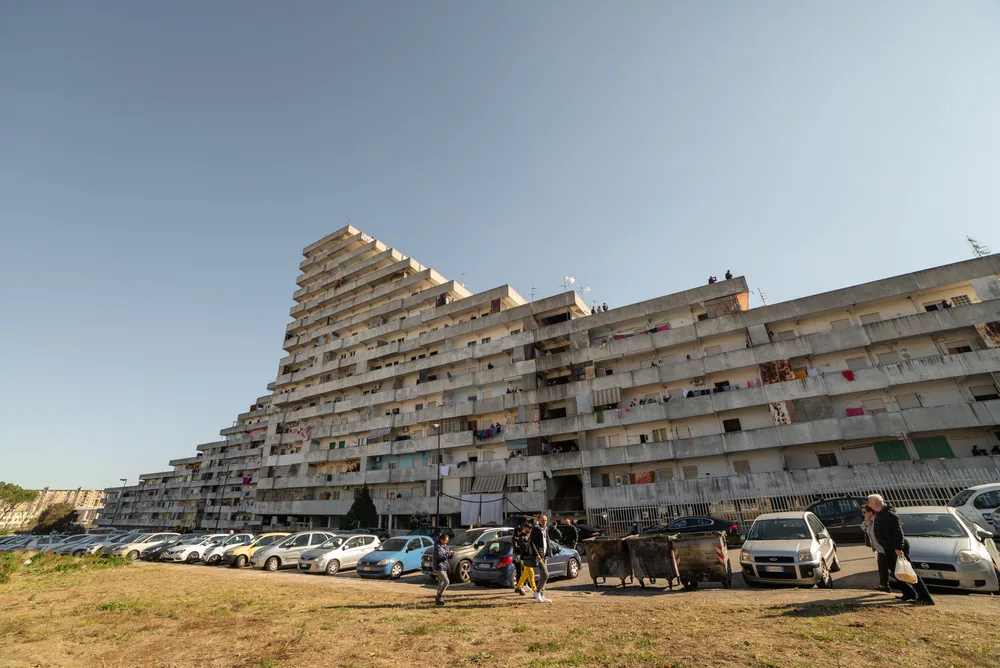
Naples – Italy. 20 february 2020: Historical day for Scampia. after 40 years the Green Sail is demolished, a symbol of degradation and set of the fiction Gomorrah/Vincenzo De Bernardo/Shutterstock
Most big cities in Italy have certain neighborhoods that are sketchy, just like big cities anywhere else.
In Rome, avoid:
- Esquilino
- San Basilio
- Corviale
Luckily, most of these neighborhoods are far away from the center. Milan has the highest crime rate in all of Italy and has several neighborhoods that visitors and locals alike should be cautious when visiting.
Avoid:
- Quattro Oggiaro
- Lambrate
- San Siro
- Giambellino-Lorenteggio
Italy’s southern cities have a reputation for being more dangerous than the north. Much of this is due to outdated stereotypes (as mentioned above, the northern city of Milan has the highest crime rate in Italy), but the south does have a higher level of organized crime.
Naples has its fair share of dangerous neighborhoods, such as:
- Scampia
- Secondigliano
- Via Marina
In most Italian cities, the area around the main train station and bus station will be sketchy at night, with homelessness and drug dealing. Try to avoid staying around there or arriving at night.
Things to Consider
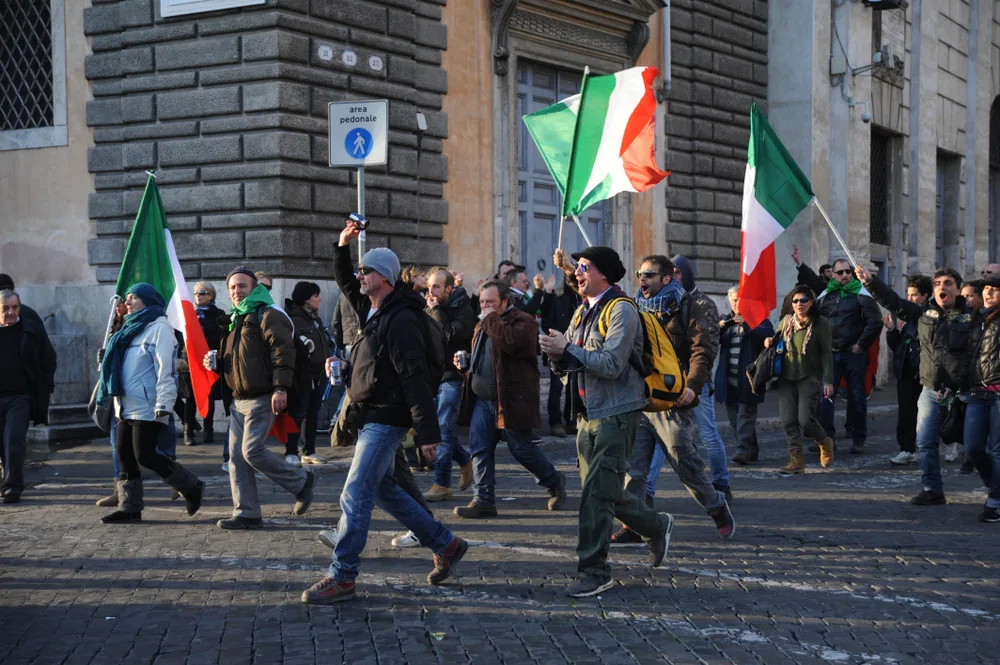
Rome, Italy: May 12nd, 2016: Supporters of the extreme far-right party protest in the streets of Rome against inmigration policy/MZeta/Shutterstock
Here are a few additional safety tips for visiting Italy:
- Avoid protests. Protests are common in Italy’s major cities and can sometimes involve clashes between protesters and police.
- Be careful of Italian drivers. Most drivers in the country have a very loose respect for traffic laws. Be careful when crossing the street as respect for pedestrians is not always paramount (especially the further south that you go).
- Be careful when trying outdoor activities. Skiing in the Italian Alps is a favorite pastime but watch the weather to avoid avalanches. When hiking, always take enough water and food, and let someone else know where you’re going.
- Stay out of the sun in the summer. Try to stay inside in the middle of the day to avoid the worst of the heat. Make sure that you drink enough water.
Frequently Asked Questions
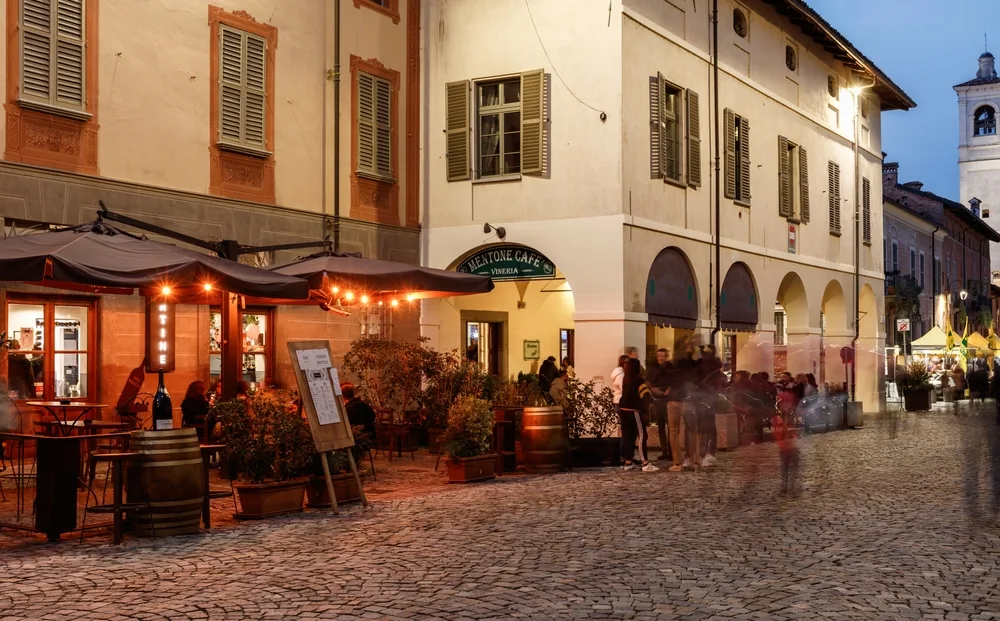
Cherasco, Piedmont, Italy – November 13, 2022: View of a street in the old town with an outdoor cafe./Michele Vacchiano/Shutterstock
Here are a few common questions that you may want answered about visiting Italy:
Is Italy a safe place to visit right now?
Yes, Italy is a safe place to visit right now! It’s always a good idea to monitor the news in case something changes right before your trip, but this country will probably be safe to visit for a while.
What should I be careful of in Italy?
You should be careful of thieves in Italy. They often target tourists and are very clever in how they part visitors from their valuables.
Is Italy friendly to foreigners?
Most Italians are friendly to foreigners, but some residents of places suffering from overtourism, such as Venice, are starting to get frustrated with tourism. Unfortunately, there have also been cases of racially motivated hate crimes in Italy before.
Is Milan safe to walk at night?
Milan has Italy’s highest crime rate, but parts of the city are still safe to walk at night. Just make sure that you stick to areas where you see plenty of other travelers.
What are the safest cities to visit in Italy?
Smaller cities in Italy tend to be the safest to visit. This includes Siena, Verona, and the Sardinian capital of Cagliari.
So, Is Italy Safe to Visit?
When you visit Italy, make sure that you are not careless with your belongings as pickpockets are common. As long as you take precautions, you should have a safe time in the country.
So, with so much to see and do and a very safe environment in which to stay, what are you waiting for — book your trip today and experience for yourself all that Italy has to offer. Happy travels!



